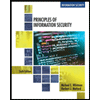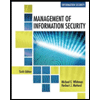
Explanation of Solution
Designing an electronic monitoring plan in order to secure resources and information:
Electronic monitoring plan design
Electronic monitoring:
Electronic monitoring system is important in an organization or any other places. CCTV is one of the monitoring systems, which are placed in a corner of a room. It should be constantly monitored and checked.
Burglar alarm:
It is the most commonly used alarm system. It is used to find out interferences into unauthorized places and it alerts the remote security agency. They should be checked periodically.
Sensors of burglar alarm:
Burglar alarm contains various sensors like,
Motion detectors:
- Burglar alarm with motion detector can be used in corridors, and in the server room to detect motion of trespassers or other unauthorized people.
- They are either active or inactive. They emit energy beams like infrared or sound waves or other radiation. If the energy is disturbed, the alarm gets activated.
Thermal detectors:
- Burglar alarm with thermal detector can be used in server room or in the work place.
- The thermal detectors are used to detect heat. They contain heat sensors that act in two ways.
- In the first way, the sensor works when the temperature in some areas reaches a predetermined level that is, 135 to 165 degrees Fahrenheit.
- In the other way, the sensor finds the rate of rise in temperature. Here, the sensors find the rapid increase in temperature within less amount of time.
Glass breakage detectors:
- Burglar alarm with glass breakage sensor can be used near doors or windows.
- It detects of the pane of glass is broken. They contains microphone through which they detect the breakage of glass...
Trending nowThis is a popular solution!

Chapter 9 Solutions
Bundle: Principles of Information Security, Loose-Leaf Version, 6th + MindTap Information Security, 1 term (6 months) Printed Access Card
- Describe three (3) Multiplexing techniques common for fiber optic linksarrow_forwardCould you help me to know features of the following concepts: - commercial CA - memory integrity - WMI filterarrow_forwardBriefly describe the issues involved in using ATM technology in Local Area Networksarrow_forward
- For this question you will perform two levels of quicksort on an array containing these numbers: 59 41 61 73 43 57 50 13 96 88 42 77 27 95 32 89 In the first blank, enter the array contents after the top level partition. In the second blank, enter the array contents after one more partition of the left-hand subarray resulting from the first partition. In the third blank, enter the array contents after one more partition of the right-hand subarray resulting from the first partition. Print the numbers with a single space between them. Use the algorithm we covered in class, in which the first element of the subarray is the partition value. Question 1 options: Blank # 1 Blank # 2 Blank # 3arrow_forward1. Transform the E-R diagram into a set of relations. Country_of Agent ID Agent H Holds Is_Reponsible_for Consignment Number $ Value May Contain Consignment Transports Container Destination Ф R Goes Off Container Number Size Vessel Voyage Registry Vessel ID Voyage_ID Tonnagearrow_forwardI want to solve 13.2 using matlab please helparrow_forward
- a) Show a possible trace of the OSPF algorithm for computing the routing table in Router 2 forthis network.b) Show the messages used by RIP to compute routing tables.arrow_forwardusing r language to answer question 4 Question 4: Obtain a 95% standard normal bootstrap confidence interval, a 95% basic bootstrap confidence interval, and a percentile confidence interval for the ρb12 in Question 3.arrow_forwardusing r language to answer question 4. Question 4: Obtain a 95% standard normal bootstrap confidence interval, a 95% basic bootstrap confidence interval, and a percentile confidence interval for the ρb12 in Question 3.arrow_forward
 Principles of Information Security (MindTap Cours...Computer ScienceISBN:9781337102063Author:Michael E. Whitman, Herbert J. MattordPublisher:Cengage Learning
Principles of Information Security (MindTap Cours...Computer ScienceISBN:9781337102063Author:Michael E. Whitman, Herbert J. MattordPublisher:Cengage Learning Management Of Information SecurityComputer ScienceISBN:9781337405713Author:WHITMAN, Michael.Publisher:Cengage Learning,
Management Of Information SecurityComputer ScienceISBN:9781337405713Author:WHITMAN, Michael.Publisher:Cengage Learning, Systems ArchitectureComputer ScienceISBN:9781305080195Author:Stephen D. BurdPublisher:Cengage Learning
Systems ArchitectureComputer ScienceISBN:9781305080195Author:Stephen D. BurdPublisher:Cengage Learning Fundamentals of Information SystemsComputer ScienceISBN:9781337097536Author:Ralph Stair, George ReynoldsPublisher:Cengage LearningNp Ms Office 365/Excel 2016 I NtermedComputer ScienceISBN:9781337508841Author:CareyPublisher:Cengage
Fundamentals of Information SystemsComputer ScienceISBN:9781337097536Author:Ralph Stair, George ReynoldsPublisher:Cengage LearningNp Ms Office 365/Excel 2016 I NtermedComputer ScienceISBN:9781337508841Author:CareyPublisher:Cengage





